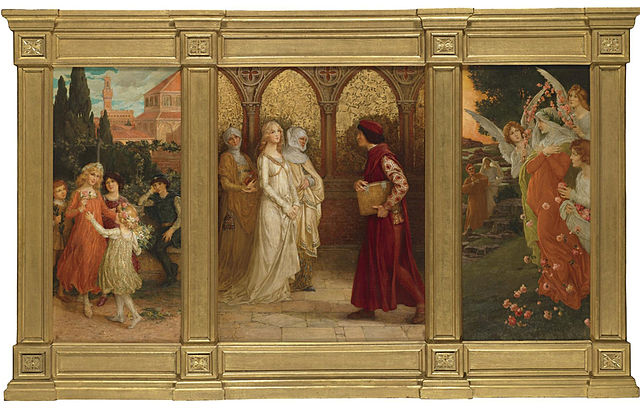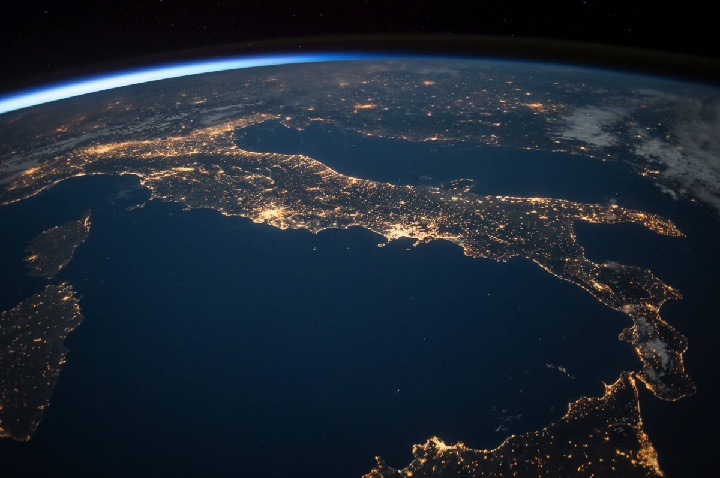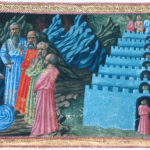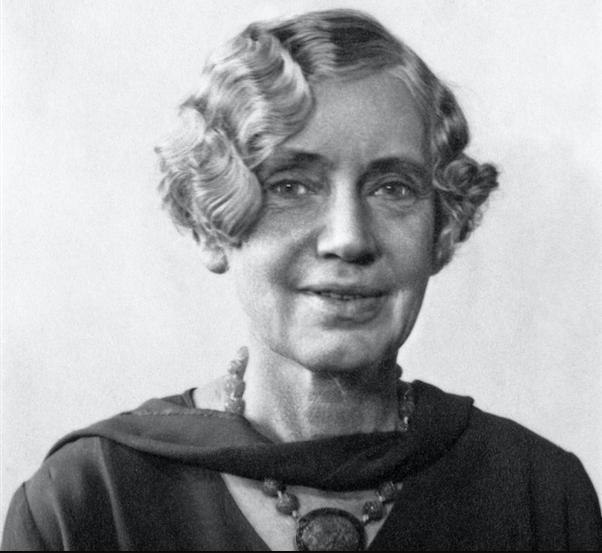
Dante’s New Love Life: the Vita Nuova
The love poets of Dante’s day told everyone they were in love: but always kept the name of their beloved secret. Dante however, names Beatrice as his love. In telling us of her, he has made her immortal. Gemma di Manetto Donati, Dante’s actual wife, he never once mentions and she is virtually unknown. Before we jump to conclusions about what this might mean let us learn more about Dante’s love life.
Vita Nuova
Dante’s Vita Nuova (“New Life”), which is Dante’s best known work as an early poet, is all about “love”. Dante recounts for us a love story and he is the lover and Beatrice the beloved. Some dispute whether Vita Nuova “really happened” or was a careful literary fiction. It doesn’t really matter however, because the experiences it shares are real enough and have occurred in many lives millions of times over.
However, by the time Dante compiles Vita Nuova, Beatrice, is already dead. Vita Nuova is a collection of 31 of Dante’s early poems and Dante tells the love story through a commentary he weaves around the poems. Right from the start Dante tells us the work will be about Beatrice.
Nine times already since my birth the heaven of light had circled back to almost the same point, when there appeared before my eyes the now glorious lady of my mind, who was called Beatrice even by those who did not know what her name was.
Verse II.1, Vita Nuova and translation, Princeton Dante Project, critical text of the Società Dantesca Italiana
The Dante of the poem is but nine when he meets Beatrice: and her name means She Who Makes Blessed. Also from the beginning, we see Dante’s attention to the astronomical world, as the universal time piece of his poetry.
The Power of Love
This first encounter leaves Dante convinced he has met a “God more powerful” than himself. Similar confessions have been made by love poets before Dante, and the first verses announce the genre of his poetry. It is in the “dolce stil nuovo” (“the new sweet style”) of the Siculo-Tuscan poets, which carried forward the traditions of the love poetry of the Sicilian court, to the south, and the “canso” love-poems of the Provençal troubadours to the north. To the Sicilian (and later troubadour) poets, the beloved was a sovereign power, to whom they proclaimed their devoted adoration. Such patterns are those of “courtly love”; a civilising poetic movement in which winning of a lady’s favour was what it was all about. Pleasing her with good manners, courtesy and great deeds performed in her name, were how the relationship between the genders was idealised in this poetry.
Beatrice will appear nine more times in Vita Nuova. Although many believe she was Beatrice Portinari, a flesh-and-blood neighbour of Dante, her appearances in Dante’s text are sometimes other worldly. Only once does she greet him and sometimes she appears in dreams.
By contrast, the narratives themselves are often earthily present as in the story of the “screen lady”.
One day when sitting in church, Dante is admiring Beatrice across the congregation. Suddenly he realises that his gaze has been interpreted by those who have seen him as directed to another lady was sitting along his line of sight. She becomes the “screen lady”. Dante uses poetry to nurture this misunderstanding to hide the secret of his love. However, the charade gets out of control and gossip getting back to Beatrice and causes her to deny him her greeting. Dante, as befits his role as lover, plunges into misery.
Beatrice’s Presence
Indeed, Beatrice’s mere presence has the power to cast Dante deeply into the clutches of love. This he describes in an extended digression.
I must tell you that whenever and wherever she appeared, … a flame of charity was lit within me and made me forgive whoever had offended me. And if, at this moment, anyone had asked me about anything, I could only have answered, my face all kindness: “Love.” And … one of Love’s spirits, annihilating all the others of the senses, would drive out the feeble spirits of sight, saying to them, “Go and pay homage to your mistress,” and Love would take their place. And if anyone had wished to know Love, he might have done so by looking at my glistening eyes.
Nuova Vita, New Life XI, Mark Musa translation, Princeton Dante Project
Dante’s Vita Nuova
In such passages Dante recounts the inner life of a lover, as if he is exploring an unknown world. And that perhaps is the main point: to seek to understand this thing we call “love”. At first the poetry focuses on the effects on him of love of the beloved. Tiring of speaking of himself, the poet decides that from now on he will speak only praise of her. This trajectory of higher forms of love is the generally direction of the work.
I tell you, when I think of her perfection, Love lets me feel the sweetness of his presence, and if at that point I could still feel bold, my words could make all mankind fall in love.
Verse XIX.5, Vita Nuova, Mark Musa translation, Princeton Dante Project, critical text of the Società Dantesca Italiana
Death
However, death and premonitions of death soon intrude as he knows that Beatrice must die. Beatrice now starts to take on a spiritual dimension, for she next appears preceded by a lady known as “Spring”, who Dante tells us plays John the Baptist to she who follows who is “Love” itself. Soon Dante reports that those around her see her as a “most beautiful angel of heaven” and that she is “a miracle”.
Shortly after Beatrice dies, although Dante does not wish to speak directly of her death. Instead, he reflects on its meaning. The number 9 attends her death, Dante citing the time of day in the Arabian manner to place her death at the 9th hour, and her death in the ninth month, according to the Syrian calendar.
The lover’s grief now becomes the theme of several chapters until the compassion Dante receives from a new lady for a time becomes a way to console and express his grief. This becomes a torment to Dante when thoughts of disloyalty to Beatrice come to him and he distances himself from her. Later in another work (Convivio – The Banquet), Dante interprets this new lady as ‘Lady Philosophy’.
Beatrice Beatified
As we come to the end of Vita Nuova, Beatrice appears again to Dante as she had in their first meeting: a child dressed in red. Dante tells us (as he feels inadequate to writing of her as she deserves) that he will devote himself to further study and that he hopes in future: “to write of her that which has never been written of any other woman“.
Having raised Beatrice to an idealised image of love, it is as if human capacity fails and nothing we say could ever be worthy of her. It is easy however to see these words as pointing to Dante’s most famous and greatest work: The Comedy.
When Beatrice next appears, it will be in the Comedy and she will be the gracious heavenly lady whose divine intervention, on behalf of even higher powers, will directly and indirectly guide Dante to the highest paradise.
What of Gemma: Dante’s Wife?
Alas, although scattered details have come to us about Gemma di Manetto Donati, virtually nothing is known about her relationship with Dante. Although she and Dante were betrothed when they were children, they were not married until after Beatrice’s death. She came from a family more eminent than his own and the marriage was contracted by their families for purposes of political and business alliances. In a city profoundly beset with sometimes violent conflicts between its leading families, such alliances were important.
Dante and Gemma are usually said to have had three children: his sons Pietro and Iacobo, who were later to write in defence of their father’s work, and a daughter Antonia. Scholars believe all three to have been with their father in Ravenna in the last years of his life.
Boccaccio, who was the greatest and earliest promoter of Dante, spoke ill of Gemma. He says their marriage was loveless, although others question this judgement.
Feminist writers are often deeply disappointed by Dante’s portrayal of women, from the ethereal treatment of Beatrice (who is almost entirely a projection of Dante’s own inner life) to the superficial and sometimes negative portrayal of some female characters in the Comedy. The criticism is valid, but perhaps expecting Dante to be more than he could have been. No matter how high the pedestal future generations have erected for him, he will inevitably be (in the main) a man of his own time; even if one whose influence is still with us. What is certain is that he started a conversation that still continues more than 700 years after he lived.
Selected Sources
Ignazio Baldelli Dai Siciliani a Dante, in Luca Serianni and Pietro Trifone (ed), Storia Della Lingua Italiana Volume Primo, Giulio Einaudi editore, 1993, pp 581-609
H.J. Chaytor, The Troubadours of Dante, Being Selections from the Works of the Provençal Poets quoted by Dante, Oxford Clarendon Press, 1902
Robert Pogue Harrison, The Body of Beatrice, John Hopkins University Press, Baltimore, 1988
Barbara Reynolds, Dante: The Poet, the Political Thinker, the Man, I.B Taurus London 2006
Regina F. Psaki, Dante Alighieri in Rinalda Russell ed, The Feminist Encyclopedia of Italian Literature, Greenwood Press, Westport, 1997
Marco Santagata, Dante: The Story of his Life, Belknap Press, Harvard University Press, Cambridge Massachusetts, 2016
John A. Scott, Understanding Dante, University of Notre Dame Press, Notre Dame, Indiana, 2004
Marianne Shapiro, Woman Earthly and Divine in the Comedy of Dante, the University Press of Kentucky, Lexington, 1975
Image







